Blagdon Lake Birds
July 2013 News
Monday 1st July
No news from the lake today.
ECUADOR DIARY: We birded this morning around the Cabanas San Isidro, which was dripping with birds from first light. A little later, we went to visit the two Antpitta feeding stations in the grounds to see Chestnut-crowned and White-bellied Antpittas. Afterwards, I took pictures of some of the hundreds of butterflies and the flowering orchids in the in the lodge grounds by way of a change from wall-to-wall birding. We took an early lunch, then headed back to Quito over the Papallacta Pass and Alan and I birded around our hotel garden and farm late afternoon, before getting ready for our 4-day trip into the Amazon Basin tomorrow morning. We should have a short 25 minute flight back over the Andes before transferring to a motorised canoe for the 2.5 hour trip down the Napo River to Sani Lodge. I'm sorry, but I haven't had time to put any pictures up on my photo website yet, so here's two to whet your appetite for when I do get time!

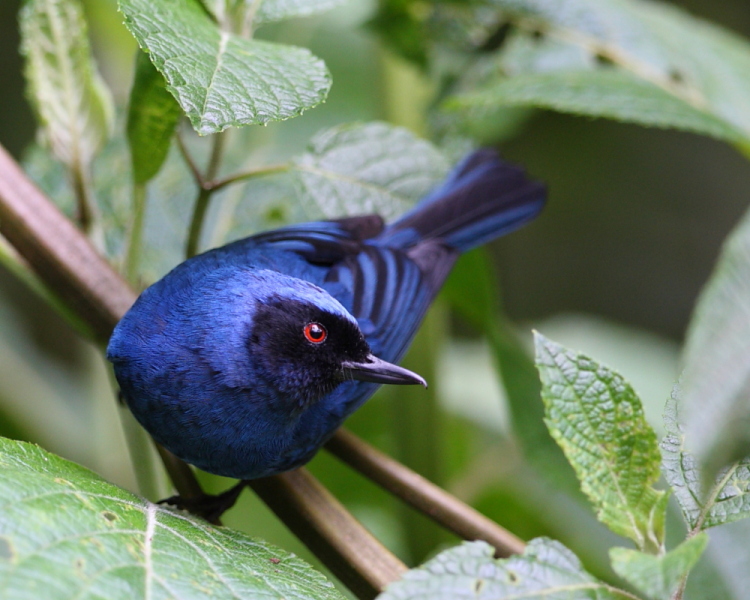
Tuesday 2nd July
News from Chris Stone today who saw: a Common Sandpiper Actitis hypoleucos, 20 Black-headed Gulls Chroicocephalus ridibundus (including 2 juveniles), a 2nd-summer Mediterranean Gull Larus melanocephalus, a probable 4th-summer Yellow-legged Gull Larus michahellis, a ♂ Aythya hybrid (probably a Tufted x Greater Scaup) and the Little Grebe Tachybaptus ruficollis brood (1 juvenile).
ECUADOR DIARY: Today we took a short flight over the Andes from Quito to Coca where we boarded a long covered canoe (fibreglass) for the 2.5 hour trip down the Napo River into the jungle, during which we saw a flock of 25 Swallow-tailed Kites. As we took to the water the heavens opened and it poured down! When we finally reached the Sani community, we had a 15 minute saunter along a boardwalk where we saw Great Potoo and Crane Hawk before boarding another, smaller, canoe which was paddled up a blackwater river to the Challuacocha Lagoon where they've set up their visitor's lodge. A welcome drink and talk was soon followed by a personal canoe trip around the lagoon, birdwatching, with our designated guide Domingo and his son Orlando. Proboscis Bats, Hoatzin, Rufescent Tiger-heron, Greater Ani, Black-tailed and Blue-crowned Trogons, a bewildering array of Flycatchers and Crested Oropendula were all penned into the list.
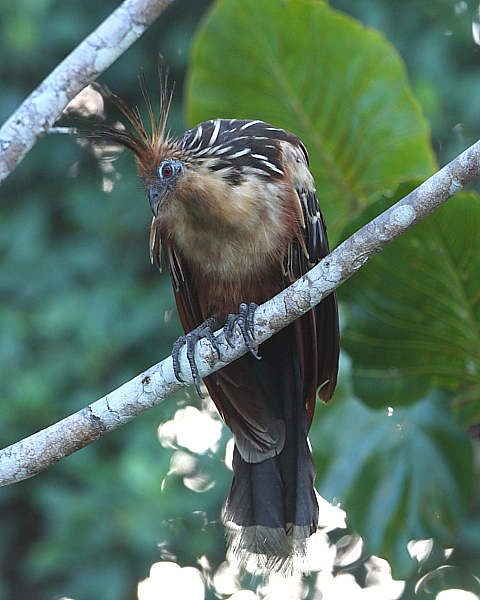
Although it had been a long day of travelling, an Aussie back-packer Larissa (Lara) and her guide Danni offered me the chance to join them for a night forest walk which I jumped at. I took my macro lens and headtorch and enjoyed an hour trundling along a trail, with Danni and his uncle pointing out all sorts of invertebrates and amphibians. I made sure I had the net over my bed securely fastened around me when I eventually hit the sack!
Wednesday 3rd July
No news from the lake today.
ECUADOR DIARY: Up before first light to meet Domnigo for breakfast, before heading up the lagoon in the canoe, with him and Orlando paddling, to the tower trail. A short walk and strenuous climb (with the photo gear on my back) saw us 100 feet up on a platform, secured to a venerable Kapok tree, overlooking the forest at first light. Magic! Then the heaven's opened for a while, before quickly clearing and allowing the birds to get on with the business of the day. We saw Black-mantled Tamarinds, Squirrel and Red Howler Monkeys in the tree-tops and the birds just kept coming, thanks to the expert eyes of Domingo and Orlando, but also at least another two or three members of the tribe who came along to help later in the morning. After 4 hours in the tree we headed back to the lodge for lunch, during which Domingo announced we were heading out shortly for a 3 hour trail walk behind the lodge. So, wellingtons donned, we headed out once again, and marvelled at Domingo's ability to locate and immitate the calls of birds near the trail. We saw Army and Leaf-cutter Ants along the trail and, after three hours, I was hot, sweaty, and flagging somewhat, so very glad to get back to the lodge for a shower and dinner. We didn't manage to finish completing our checklist before the lights went out at 2200 hrs, but we had added Greater Yellow-headed Vulture, Double-toothed and Slate-colored Kites, Laughing Falcon, Limpkin, Sungrebe, Amazon Kingfisher, Green-backed Trogon, Parrots, Guans, Toucans, Great Jacamar and lots of other passerines. It was getting mind-boggling!
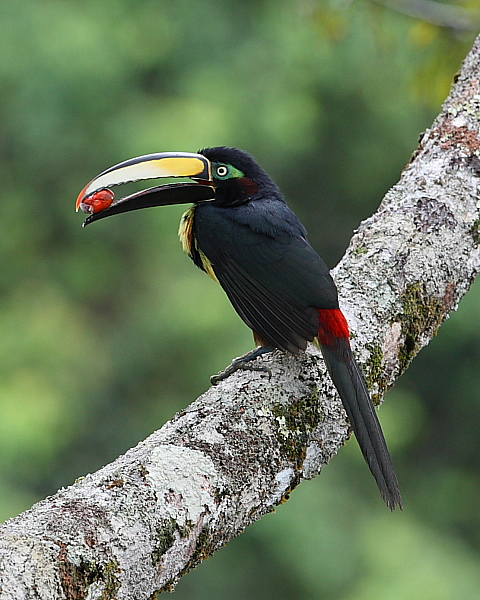
Thursday 4th July
No news from the lake today.
ECUADOR DIARY: Breakfast before dawn once again, and Domingo announced we'd spend the day exploring the Napo River islands by canoe and on foot. Our first target when out on the river was Amazonian Umbrellabird, which a German psychiatrist, Karl, had told us over dinner the evening before had taken him three trips, and which he got just as they were about to pack up on his last outing. Within half an hour, Domingo had pointed out at least 8. It was a sign of things to come, and a morning on a small island produced a variety of specialities including Riverside Tyrant. We also saw Yellow-headed Caracara, Barred-forest Falcon, 2 Collared Plovers, 2 Lesser Yellowlegs, a single Large-billed, and several Yellow-billed Terns.

We went back to the lodge for lunch, then back out again onto the river searching for more riverside birds. However, I was just starting to get a problem with my stomach and after picking over dinner I retired to bed feeling unwell. The Imodium had worked for the afternoon outing but things quickly took a turn for the worse...
Friday 5th July
No news from the lake today.
ECUADOR DIARY: A bad night left me feeling awful and somewhat delerious, so I battened down the hatches and stayed in bed all day while Alan got on with the birding. In the evening we had a conversation during which I thought I'd been in bed ill for 2 days!
Saturday 6th July
No news from the lake today.
ECUADOR DIARY: I had to get out of bed, pack and be ready for the canoe transfer back upriver to Coca by 0600 hrs which was a real effort, though I was feeling marginally better. I wasn't happy when this was delayed by an hour, though more Immodium got me through the 4 hour canoe trip, during which the motors were overheating and slowing us, until we cadged a pint of oil from a passing stone barge. Our plane trip back over the Andes and transfer to our Quito city centre was an ordeal, and I could have done without the blaring music, sirens and car horns all night, knowing that our previous guide Randy and driver Jose were due to pick us up at 0600 hrs. You may gather I was feeling sorry for myself at this point! To cap it all, Alan had started to go down with the same symptoms during the day.
Sunday 7th July
News from Sean Davies as follows: The ♀ Greater Scaup Aythya marila seen from Top End Hide. It looks like it's been commuting between the lake and Chew Valley Lake. Plus, a Common Sandpiper Actitis hypoleucos on the dam.
ECUADOR DIARY: Two beaming faces met us in the hotel lobby as arranged, and we headed out of town and up, up, up to bird a trail at the World Land Trust, Yanacocha Reserve. A 5km walk produced very little, but the 2 White-lored Antpittas that came out to the call of the gate warden when we got back made it so-o worthwhile! For the next hour we bumped our way back down a dusty trail (not great with two iffy-tummies in the car) to reach Bellavista Cloud Forest and Tandyapa Lodge for lunch. I could have happily gone to sleep in the car during lunchtime, but made the effort and was so glad I did. I managed a few mouthfuls of food (my first since Thursday) and we had some great birding right around the lodge, including a very confiding Masked Trogon. Richard made us so welcome to his conservation success-story, it was sad to have to leave. But needs must, and we continued down the hill for another hour or two birding along the way before finally making it to Sachatamia Lodge, Mindo, our home for the next three days. After a plain tortilla for dinner, which the wonderful lodge staff cooked for me specially, we saw the Black and White Owl, then Randy, Jose and I went for an owl prowl down towards the river with lightning silhouetting the mountains around us. A brief, untickable glimpse of Mottled Owl was all we could find. Alan went to bed early, feeling unwell.
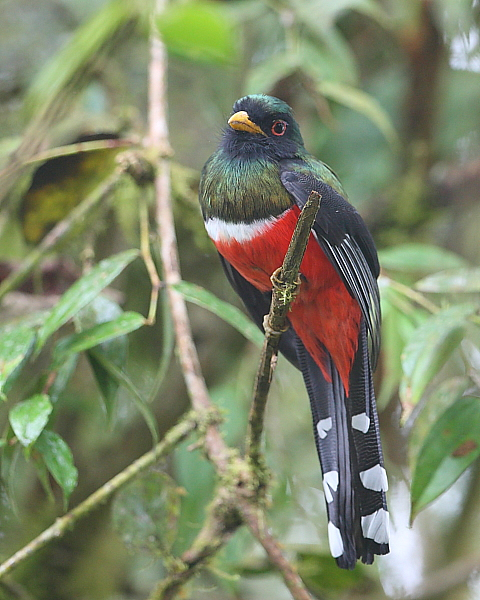
Monday 8th July
No news from the lake today.
ECUADOR DIARY: A pre-dawn start, with packed breakfast, saw us heading further down the slope to Rio Silanche Bird Sanctuary for the morning. We birded a trail at first light, then climbed the 30 foot observation tower to eat breakfast and bird the morning away. At this lower altitude of 300-350 metres, the suite of birds was very different, and a steady stream came past us in the canopy. We even spotted a distant Hook-billed Kite, which we later realised was perched right next to a Bat Falcon nest! We had a few mixed flocks through during the morning and I managed a few photos in some half decent light before we headed back to the lodge for lunch. We bagged Choco Trogon among a host of new tanagers. Afterward, we headed into Mindo, Randy's home town, and spent some time on Rodney Garrido's wonderful El Descanso hotel balcony, watching the hummers and fruit-eaters come in and out. His garden list is 126 spp. Alan is still very unwell, and I'm not too much better, though getting a couple of pictures of White-capped Dipper by the river in Mindo was pleasing to say the least.
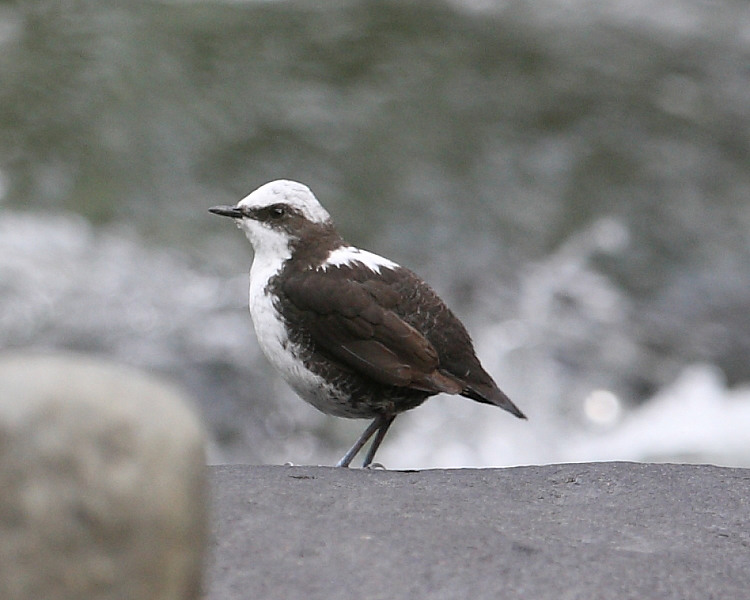
Tuesday 9th July
No news from the lake today.
ECUADOR DIARY: Alan had a very bad night and decided to stay in bed. I was very concerned about his condition and asked Randy to arrange a visit to his pharmacia when we got back from our pre-dawn visit to a Cock-of-the-Rock lek. We saw about 20 males dancing around in the gloomy conditions, no use at all for photography, and at 0700 hrs popped down the road to see a roosting Lyre-tailed Nightjar on a cliff face. This amazing little 9" ♂ bird has tail streamers 20" long! Then it was further up the hill to visit Paz de Los Aves (the 'Antpitta Whisperer'). A welcoming coffee (for those who like it) was followed by a great couple of hours watching Sickle-winged Guan, Toucan Barbet, Emerald Toucan and Empress Brilliant, capped by 3 Streak-breasted Antpittas. Breakfast was included, but I was still not eating much and when the owner realised I had a bad stomach, he disappeared into his farm garden and came back with some ingredients to make a medicinal mug of tea to help me get over it. What's more, his wife made up a flask of the same for us to take back to Alan at the lodge. We were surprised and relieved to find him up out of bed, but nevertheless headed into Mindo where the pharmacist gave him a couple of courses of tablets to help settle things down. I elected to continue my own slow recovery without tablets. We searched the rivers around Mindo very hard for Sunbittern and were on the way to our last gasp stop, when Jose spotted a Fasciated Tiger-heron from a bridge. Bingo! Randy's home patch knowledge came up trumps when Alan spotted a Sunbittern walking on the grass beside the river. However, his excited shout of "there it is", flushed it away down the river giving spectacular views of the upperwings - but no photo! The lodge cook continued to make special request meals for Alan and I right to this last night and we shared a bottle of wine with Randy and Jose to celebrate today's success.
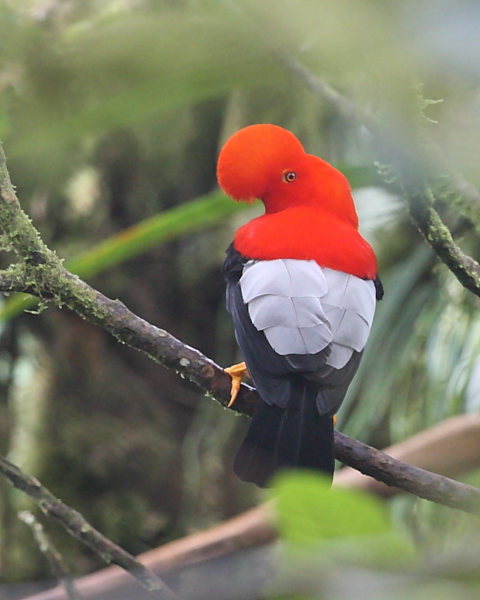
Wednesday 10th July
No news from the lake today.
ECUADOR DIARY: A leisurely 0600 hrs breakfast was followed by a 3 hour drive back to, and through, Quito to visit the Paramo of Antisana and La Mica (lagoon) at 4000 metres altitude. On the way up we saw circa 20 Andean Condors; a most extraordinary sight. Driving over the high plateau we picked up Black-faced Ibis, Andean Lapwing, Carunculated Caracara and Black-winged Ground-dove. Then, at the end of the road, the long-awaited visit to a high level lake (source of some of Quito's water supply) brought Andean Ruddy Duck, Yellow-billed Pintail and Silvery Grebe, though again, rather disappointingly too far away to photograph. While we were up there, two Cinereous Harriers flew over. Then it was back down again, with lunch on the way, to the Garden Hotel San Jose by the airport to relax and take it easy for the long flight home starting tomorrow afternoon. We said our fond farewells to Jose and Randy for their fantastic guiding, and this afternoon had a preliminary tot-up - I reckon I've seen 378 spp. Remarkable for what has effectively only been 11 days birding, thanks to my tummy bug. We've been on the go the whole time, leaving me no time to sort out photos, but after a trip up north to visit family when I get back, I'll get stuck into them and put up a gallery on my photo website.

We have got time for a quick whizz around outside the hotel in the morning, but I think finding another 22 spp. for the 400 is a bit of a stretch!
Thursday 11th July
No news from the lake today.
ECUADOR DIARY: Alan and I took a stroll around the farm and garden this morning and added another three species to the list and I've got another pending. But that's it for now, I've got to pack up the laptop and take the bags to reception. We're on our way home via Amsterdam, and due to get back into Bristol tomorrow evening.
Friday 12th July
I arrived home at 1730hrs this afternoon, and after a quick shower, Celia and I went down to the MShed in Bristol to join the launch party for the new Dragonflies and Damselflies of the Bristol Region. It looks like an excellent publication and should be on every local naturalists bookshelf. I hope it encourages an upsurge in recording locally - try and fill in some of the gaps on the maps, so that the distribution of each species is as accurate as it can be.
Saturday 13th July
News from Sean Davies today as follows: "This morning 4 Common Sandpipers Actitis hypoleucos (Dam/Cheddar Water), Common Redshank Tringa totanus (Dam), Common Tern Sterna hirundo (Home Bay)."
Sunday 14th July
No news from the lake today.
Monday 15th July
No news from the lake today.
I am planning to meet with Joanna Dailey at Kielder Water in Northumberland tomorrow, and hope to bring back a report on Osprey Pandion haliaetus white 'YA' who gave us such pleasure (and not a few headaches) at Blagdon over Easter, as he made his way north to breed.
Tuesday 16th July
No news from the lake today.
I duly met Joanna Dailey at lunchtime today, in Kielder Castle Cafe, and we spent a couple of very interesting hours watching the Ospreys on both nests via the webcam there. White 'YA's older brother Yellow '37' and his partner have three good-sized young that are about a week away from fledging according to Joanna. White 'YA's partner was sitting on the nest with their remaining youngster (the smallest of three, the other two having sadly died, possibly due to a bug or during bad weather). It's 'in pin' with the feathers just starting to come through, so still at some risk from poor weather, though the sun was shining up here today and mum was providing shelter in her shadow. I think Joanna said the youngsters are ringed at around 5-6 weeks, so we'll have to wait until then to find out what sex the chick is. It was nice to see them on the nest and for a few wonderful moments, 'YA' dropped onto the nest too, providing us with a lovely family portrait. After he left to sit on a nearby tree, the ♀ fed the chick with strips torn from the tail end of a trout that was on the nest. By the time the feed was over, it's little crop was fair bulging!
During the afternoon Joanna and I went to the old Osprey watch site and had distant views of White 'YA' and family through our scopes, though the heat haze made it difficult at times. We also viewed them from another spot, this time during a cloudy spell, which gave clearer viewing. White 'YA' then flew over the forest towards the reservoir and we hoped he was going to fish in front of us, but he climbed high over the far bank and then went into a long shallow glide towards the dam where he often fishes. Joanna, Celia and I went there but unfortunately missed him. So, what a lovely afternoon it was, catching up with an old acquaintance, and I'd like to publicly thank Joanna for her time and friendship showing us around 'her patch' - she was both immensely informative and could hardly have arranged more perfect sightings of the Kielder Opsreys!
Wednesday 17th July
No news from the lake today.
Celia and I spent the day around Kielder Water today, but everything I wanted to do (e.g. photograph Adders, Red Squirrels etc.) didn't come off, though we did see at least one of the Ospreys hunting near the dam late in the afternoon. I photographed a few Common Spotted Orchids Dactylorhiza fuchsii, which are putting on a magnificent display beside the Lakeside Trail, and saw good numbers of Lesser Redpoll Carduelis cabaret and Eurasian Siskin Carduelis spinus, but I guess it was just one of those days you put down to experience. I was taken aback to see a couple of Common Goldeneye Bucephala clangula fly over the road in front of the car on the way to the pub for our evening meal. Perhaps they're breeding up here? I photographed a longhorn beetle Pachytodes cerambyciformis.
Tomorrow, I'm hoping to go over to the Farne Islands and visit Inner Farne with the cameras, before making the long trek home in the evening.
Thursday 18th July
No news from the lake today.

Celia and I drove across Northumberland today, from Kielder to Seahouses, through the spectacular landscape with its huge vistas and right past the front door of one of my favourite houses, Cragside. Unfortunately, we didn't have time to stop as we had a boat to catch to the Farne Isles. Today was my third visit to this amazing bird colony with its thousands of terns, Puffins, Shags, gulls and auks. I had a lovely time with my camera (see Recent Images Gallery), albeit not long enough, and to cap it all I even saw the Bridled Tern!
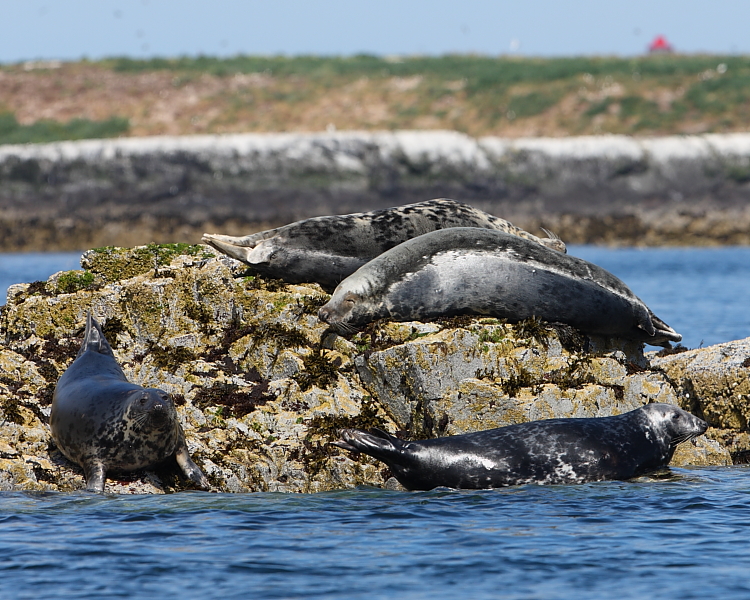
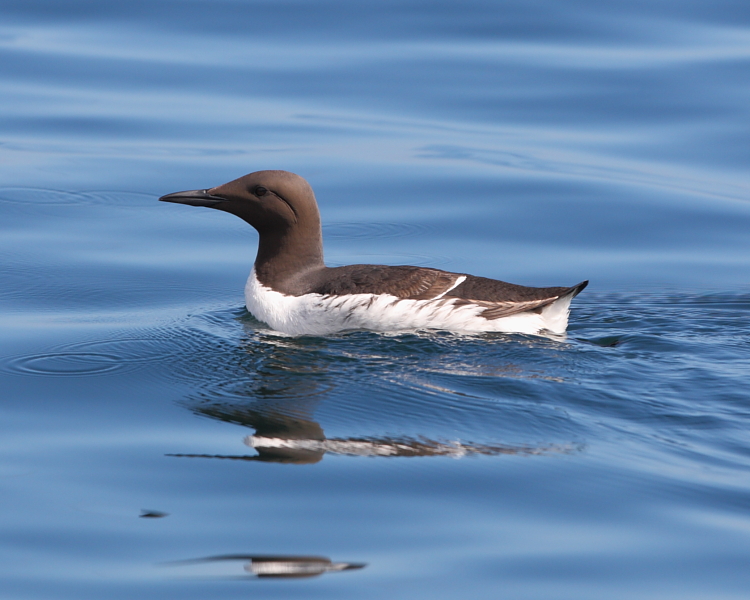
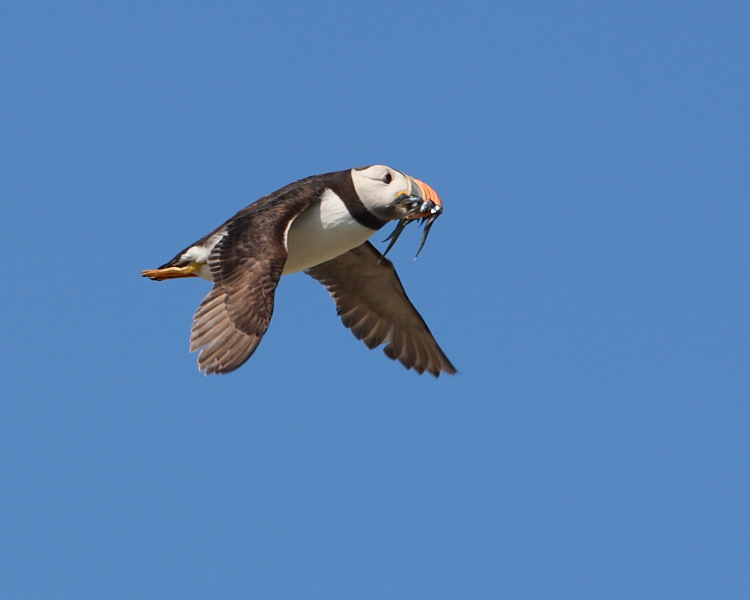

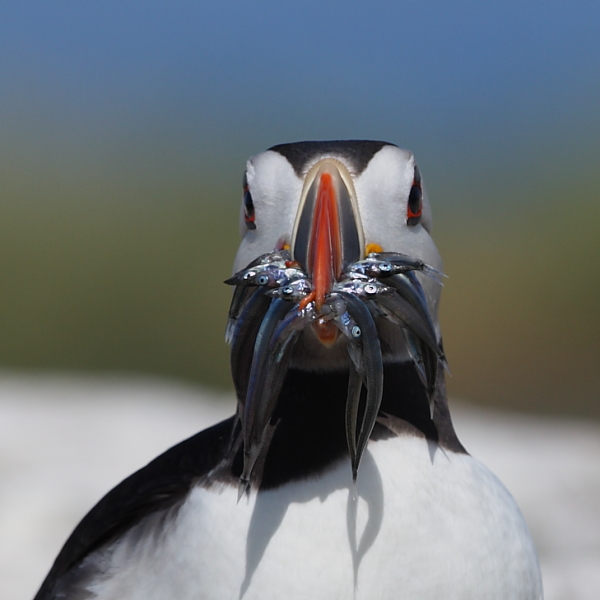
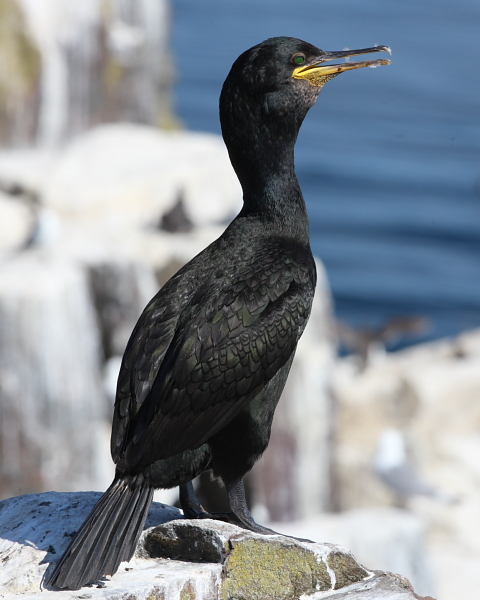
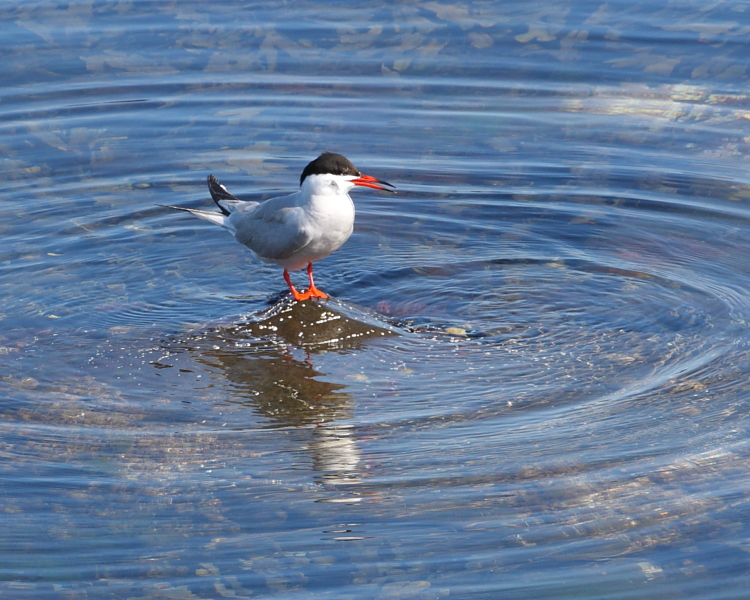
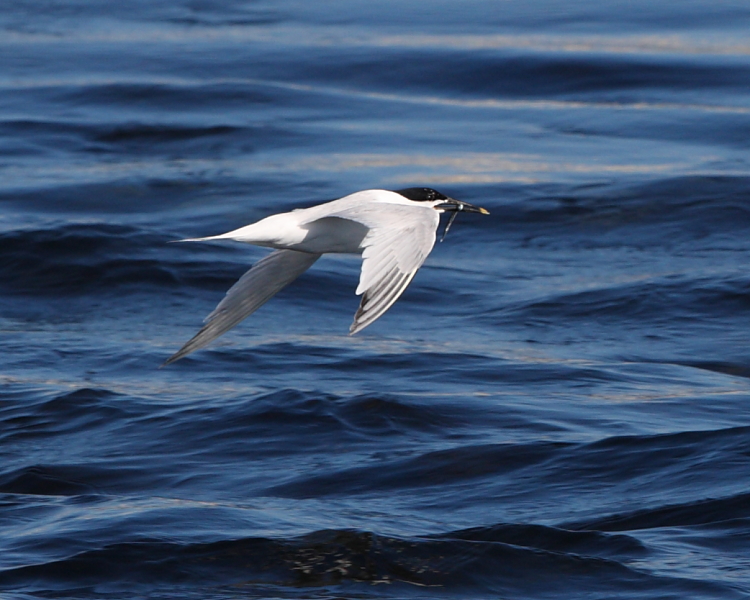
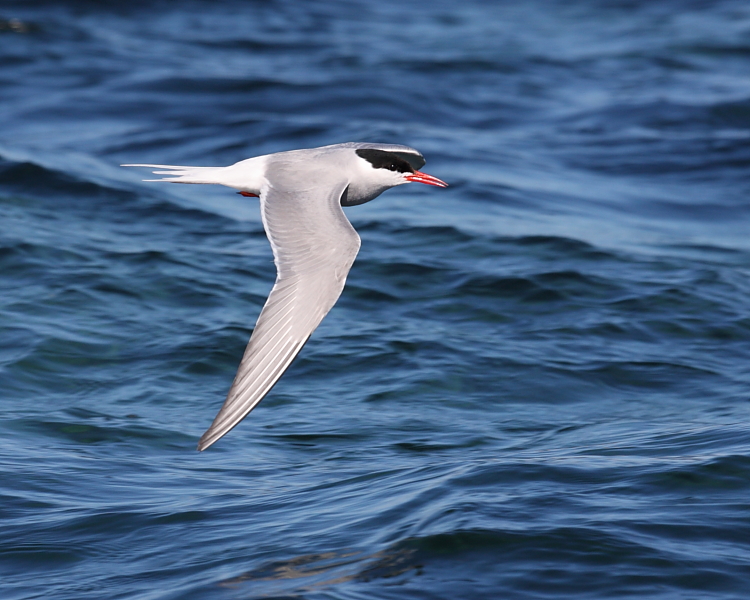
Joanna Dailey kindly sent me an email saying she sees Common Goldeneyes at Kielder, but isn't sure if they breed there. I'll submit the record to the Northumberland bird recorder anyway. Of course, the long awaited Bird Atlas 2007-2011 will be on our shelves any day soon and will no doubt have the answer.
We drove home in the evening and tomorrow I am on the Somerset Levels with photographers Robin Williams, Peter Douglas-Jones and Harold Grenfell of the Nature Photographic Society. On Saturday we will be carrying out the monthly WeBS count, so there's no let up!
Friday 19th July [Scorchio!]
I made it to the dam this evening and counted 4 Common Sandpipers Actitis hypoleucos, then later I received an email from Paul Williams who saw 5, but not much else. I will be carrying out the WeBS count on my own tomorrow, so it will be my chance to have a really good look around. The water level has certainly dropped in the 3 weeks I've been away and Bristol Water were reporting the lake was 79% full on the 16th.
My trip to the Somerset Levels was interesting, with a ♂ Garganey and 2 broods of Gadwall on Meare Heath lagoon and 2 Eurasian Bitterns in flight. Noah's Lake had an Osprey all afternoon, a ♂ and 2 ♀/imm Marsh Harriers and 2 Common Sandpipers.
Saturday 20th July [Cloudy and cooler with a steady breeze]
It was great to be back on my own patch this morning to do the WeBS count. There was nothing wildly exciting to report, but the water level is beginning to look good, there were hardly any anglers out due to the warm water, and there has been extensive weed growth while I've been away. I will take a closer look through the Aythya flocks later today or tomorrow, because I wouldn't be surprised to find a Ferruginous Duck or Greater Scaup among them. Common Coot Fulica atra, Tufted Duck Aythya fuligula and Mallard Anas Platyrhynchos numbers were all up substantially on last months count and I'd expect in excess of 1000 Coots and near that number of Tufted Ducks next time, on what will probably be the biggest count of the year.
Many of the meadows have already been hay cut (a tad early perhaps?) but I saw my first lakeside Small Skipper Thymelicus sylvestris at Bell's Bush along with Marbled White Melanargia galathea. Bell's and the Top End meadows have yet to be cut and the Devil's-bit Scabious Succisa pratensis is putting on a wonderful display.

We are hosting the UK National Nathusius' Conference at Ubley Village Hall on 24th August. Details of the programme are on the Bat News Page. Get in touch with Daniel if you'd like to come along.
Joanna Dailey wrote a few words about my visit on the Kielder Osprey Blog and has continued to add information about Osprey white 'YA's chick (click on the link above the daily news on the right side of the page "Blue 4H takes the biscuit. Or fish!" to move forward) and has even included a short video and a very nice family portrait on the nest. The chick is standing and starting to feed itself now.
Sunday 21st July [Scorchio again!]
I didn't spend too long at the lake today, it was very warm, but this evening I saw at least 4 Common Sandpipers Actitis hypoleucos on the south end of the dam. I had a fairly close look at the Aythya ducks but couldn't see anything other than Tufted Ducks Aythya fuligula and Common Pochards Aythya ferina. I'm going to spend as much time as possible there tomorrow, looking at the birds and more especially the invertebrates because there should be a whole new suite of Hoverflies, Dragonflies and Butterflies on the wing since I went away. Some meadows have yet to be cut, so will be a good place to start. I saw the unwelcome Twin-lobed Deerfly Chrysops relictus buzzing around me at Bell's Bush yesterday!
Monday 22nd July [Scorchio!]
The stifling heat continues and I ended up calling it a day by mid-afternoon. I went back this evening and counted 6 Common Sandpipers Actitis hypoleucos on the south end of the dam (there may be more), and checked through the wildfowl at Top End this afternoon without finding anything unusual. I looked for hoverflies at Wood Bay, saw a few Syritta pipiens, and took a couple to be determined:
- Cheilosia illustrata 1♂ [first site record]
- Syrphus vitripennis/rectus 1♂ (Note that males cannot be reliably separated at present)
Then I went to Top End and saw some more Skipper sp. so decided to net a few to check them, and of four caught, two were Small Skippers Thymelicus sylvestris and two were ESSEX SKIPPERS Thymelicus lineola. I decided to try and photograph one of the Essex Skippers, uncontrolled, at which point Robert Billingsley drove up. He'd never seen Essex Skipper so we caught another two Skippers for examination, which turned out to be one of each species. I've checked the NBN Gateway website and I believe these to be the first records for Blagdon.

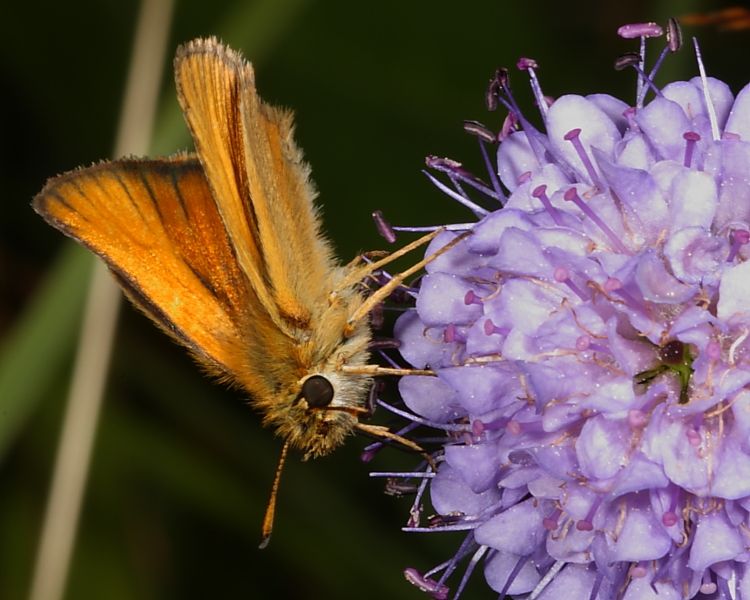
I've just had an email from Geoff Davies courtesy of the good offices of Nick Hawkridge to say that he saw an adult Red Kite Milvus milvus at the end of his BBS on 7th July on the North Shore. This becomes the 7th lakeside record see species account.
I ran my 15W Heath Trap overnight (min. temp. 16 Celsius) at Home Bay Point and caught:
- B&F0424 Bird-cherry Ermine Yponomeuta evonymella 2
- B&F1234 Regal Piercer Pammene regiana 2 [first site record]
- B&F1293 Garden Grass-veneer Chrysoteuchia culmella 2
- B&F1708 Single-dotted Wave Idaea dimidiata 1
- B&F1738 Common Carpet Epirrhoe alternata 1
- B&F1994 Buff-tip Phalera bucephala 1
- B&F2044 Dingy Footman Eilema griseola 1
- B&F2050 Common Footman Eilema lurideola 6
- B&F2064 Ruby Tiger Phragmatobia fuliginosa 1
- B&F2102 Flame Shoulder Ochropleura plecta 1
- B&F2198 Smoky Wainscot Mythimna impura 6
- B&F2318 Dun-bar Cosmia trapezina 1
Also, lots of beetles, harvestmen and caddis-flies none of which I retained except:
- Sexton Beetle Nicrophorus vespillo 1 [first site record]
Unfortunately, with the heavy overnight rain and thunderstorms, the trap got very wet and soggy inside so I just wanted to release everything else pdq.
Tuesday 23rd July [Overnight thunderstorms, hot and humid]
When I went to check my moth trap (see catch details for 22nd) this morning, I found an adult Little Ringed Plover Charadrius dubius at Green Lawn. There were 7 Common Sandpipers Actitis hypoleucos on the dam this evening.
I spent some time at Top End this afternoon trying to photograph Skipper butterfly spp. I saw 3 species, including a rather worn Large Skipper Ochlodes faunus, and quite a few Silver Y Autographa gamma moths as well. Then I went over to Rugmoor and the first small Skipper sp. that I found turned out to be an Essex Skipper Thymelicus lineola too. Afterward, I went back and collected and photographed some hoverfly spp. that I'll go through as I find time:
- Helophilus hybridus 1♂
- Helophilus trivittatus [first site record]
- Sphaerophoria sp. 1♂ (to be gen. det. when dried)
- Platycheirus clypeatus 1♀ & 4♂
I ran my 15W Heath Trap overnight (min. temp. 14 Celsius) at Pipe Bay Copse. It was nice to see quite a few moths in the trap for the first time this year, albeit there was nothing new:
- B&F0424 Bird-cherry Ermine Yponomeuta evonymella 1
- B&F1961 Light Emerald Campaea margaritata 1
- B&F2030 Yellow-tail Euproctis similis 1
- B&F2033 Black Arches Lymantria monacha 1♂
- B&F2044 Dingy Footman Eilema griseola 2
- B&F2050 Common Footman Eilema lurideola 15
- B&F2064 Ruby Tiger Phragmatobia fuliginosa 1
- B&F2102 Flame Shoulder Ochropleura plecta 1
- B&F2107 Large Yellow Underwing Noctua pronuba 4
- B&F2128 Double Square-spot Xestia triangulum 11
- B&F2193 Clay Mythimna ferrago 1♂
- B&F2198 Smoky Wainscot Mythimna impura 1
- B&F2321 Dark Arches Apamea monoglypha 1
- B&F2336 Double-lobed Apamea ophiogramma 1
- B&F233x Minor spp. Oligia spp. 3 (not determined)
- B&F2381 Uncertain Hoplodrina alsines 2
- B&F2441 Silver Y Autographa gamma 1
Wednesday 24th July [Hot and sunny]
When I went to check my moth trap (see catch details for 23rd) this morning, there were at least 5 Common Sandpipers Actitis hypoleucos still around the dam end of the lake.
This afternoon I spent a short while watching Three-spined Sticklebacks Gasterosteus aculeatus in the stream at Bell's Bush barrier and there was one ♂ in particularly fine breeding garb (red throat and blue tinges around the eye) that was chasing many of the others that dared to approach his patch. There were also good numbers of the Dolichopodid fly Poecilobothrus nobilitatus with the ♂♂ doing their wing-waving display on the wet mud and water surface of the inlet. It is a very easy species to identify due its white wing-tips and metallic green body. I struggled to find much variety in the hoverflies at Top End today, but there were lots of bumblebees on the Devil's-bit Scabious Succisa pratensis. There were very few insects at all on the Common Hogweed Heracleum sphondylium flowers at Wood Bay, usually a good food source for many hovers. Perhaps I'll have to check some woodland areas next.
Hoverflies caught today:
- Helophilus hybridus 1♂
- Eristalis interruptus 1♂
- Eristalis intricarius 1♂
Thursday 25th July [Hot, with sunny spells]
No moth trap deployed last night due to forecast rain, so I went down to the lake mid-morning. I saw 5 Common Sandpipers Actitis hypoleucos and an adult Yellow-legged Gull Larus michahellis. As there has been a Lesser Emperor Dragonfly seen at Cotswold Water Park, I thought I'd have a look around the Lodge for dragons on the wing. I spotted just one, too far away to identify, but there were lots of damselflies out over the open water. I have seen the odd Black-tailed Skimmer Orthetrum cancellatum, Emperor Anax imperator and Southern Hawker Aeshna cyanea in the last few days, but not a single darter yet.
This evening I counted 6 Common Sandpipers on the dam and saw the Tufted Duck Aythya fuligula ♀ and 8 juveniles (1st brood, 2013) at Rugmoor Point. I first saw them yesterday at Top End but forgot to mention it last night. I also counted 36 Common Pochards Aythya ferina this evening.
Friday 26th July [Warm and sunny]
This evening I popped down to the lake and saw 3 Common Sandpipers Actitis hypoleucos on the south end of the dam, but nothing else of note because it was just too dark to go through the Top End wildfowl. I will have time for a proper look tomorrow.
I was away most of the day walking the South West Coast Path from Abbotsbury to Seatown in Dorset, a distance said to be 12.4 miles but which came out at 13.3 on my GPS. We also walked another 1.5 miles to and from bus stops. It was a lovely walk during which we saw a Painted Lady Vanessa cardui, my first of the year, at Burton Mere and some huge Wild Leeks Allium ampeloprasum flowering along the path nearby.
Saturday 27th July [Warm and overcast with steady rain later]
At lunchtime there were still 5 Common Sandpipers Actitis hypoleucos around the dam end and 4 Grey Wagtails Motacilla cinerea on the dam wall itself (probably the brood from the nest nearby). There were probably a couple of thousand waterbirds tucked into the area between Top End and the extensive weed beds across the lake from Rugmoor to Wood Bay Points. I had a distant look through them from Rainbow Point where you can see most of Top End, unlike from the hide where high marginal vegetation obscures much of the view, and again later from Bell's Bush.
Sunday 28th July [Cooler with sunny spells and a good breeze]
I only found a single Common Sandpiper Actitis hypoleucos today, at Green Lawn, and despite spending the afternoon looking around there wasn't much else to write about until I was heading back and found a large number of gulls on a barley field that has just been cut on Holt Farm. I spent a while looking through them for birds with darvic rings but couldn't find a single one. However, I did spot 2 adult Common Gulls Larus canus among them, only the fourth July record for the lake that I can find on my database, the last being of an adult I saw on 20th July 2002.
Monday 29th July [Warm and sunny, with occasional thundery showers on a strong breeze]
At last, something different to write about. There were 3 Black-tailed Godwits Limosa limosa (race not determined) in Rugmoor Bay late this afternoon. Also, noted were a Common Sandpiper Actitis hypoleucos on Butcombe Bank and another, a juvenile, on Home Bay Point as well as an adult Yellow-legged Gull Larus michahellis and 2 broods of Common Coot Fulica atra (each with a single juvenile) and one of Common Moorhen Gallinula chloropus (again, with a single juvenile).
Tuesday 30th July [Warm and sunny]
Disappointingly, the Black-wits have moved on and the only significant bird I saw was a single Common Sandpiper Actitis hypoleucos on the dam. I caught a brief glimpse of the back end of a large brown-backed raptor that really upset the large gulls and caused everything to fly off Rugmoor Point, but it was chased over the Indian Country pines by a Greater Black-backed Gull Larus marinus and disappeared. I'm guessing it was either a Marsh Harrier or Osprey, but despite spending the rest of the afternoon by the lake I didn't see it again.
I caught and released the very striking Conopid fly Physocephala rufipes this afternoon while looking for new hoverflies. I just wish I'd had a camera with me though! I saw a few common species already recorded for the site and took just four to check:
- Platycheirus granditarsus 1♂
- Eupeodes corollae 1♂ [first site record]
- Syrphus vitripennis 1♀
- Chalcosyrphus nemorum 1♀ [first site record]
I also caught the lovely little Tortrix moth Pammene aurana on a Common Hogweed Heracleum sphondylium flower at Wood Bay, again, a first for the site.
Wednesday 31st July [Overcast with rain and drizzle. Warm.]
When I was checking the dam, where there were 2 Common Sandpipers Actitis hypoleucos, I heard the unmistakable call of Eurasian Oystercatchers Haematopus ostralegus and, eventually, I spotted 3 flying around quite high above the dam end. They settled on Green Lawn briefly, where I scoped them and decided they were all adults, before they were put to flight again by anglers.
July has been the second month this year in which we've had above average rainfall, but according to the Bristol Water website the lake has continued to drop (5% since the 16th) and the level was 74% today. I've just looked at the 2011 archive and the lake was 76% full on 26th July in that memorable year for wader migration. Let's hope things continue to shape up in the same fashion, as Autumn draws closer.